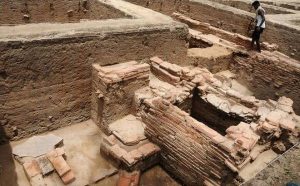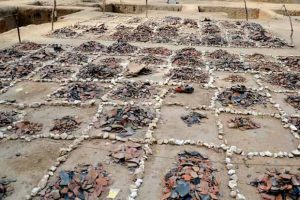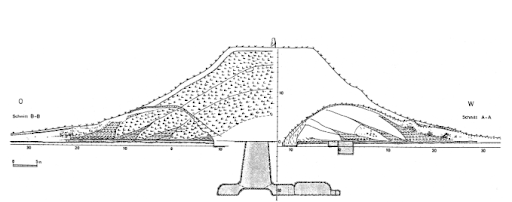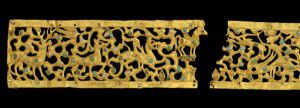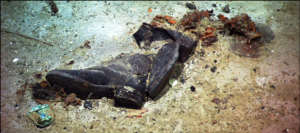Alcohol production and consumption is present in almost every major culture in the world, with most societies cultivating their own unique alcoholic beverages. Alcohol can often reveal important information about the spiritual and social structure of an ancient society, as well as show how far the culture’s influence may have spread.
The oldest alcoholic beverage ever found was in Jiahu, a settlement in North-Eastern China dating back to around 7000 B.C. (McGovern 2019) Archaeologists from The Henan Provincial Institute of Cultural Relics and Archaeology have been excavating the site since the 1980s, and discovered- after performing chemical analysis of the residue on ceramic pots- trace amounts of a fermented beverage made from honey, rice, and fruit. (McGovern 2019)

Image 1: Neolithic jars used to hold early alcoholic beverages, discovered at Jiahu. ca. 7000-6600 B.C. Photo: Z Juzhong, Z. Zhang, and Henan Institute of Cultural Relics and Archaeology
The alcohol discovered at Jiahu does not neatly fit into any of our modern day classifications such as beer or cider, however, wine has been in production for around 7,000 years, with the earliest examples being traced back to 5,400 in present day northwestern Iran. (Malin 2014) Ancient Egypt is known as one of the biggest producers of wine and beer in the ancient world, connecting the highest and lowest on the social pyramid in the shared enjoyment of drinking. Models of breweries, often put alongside bakeries, have given valuable insight into the scale of the brewing operations of the time, as well as indicating the influential role played by women handling alcohol production. (Mark 2017)

Image 3: Model Bakery and Brewery found in the tomb of Ancient Egyption chancellor Meketre. ca. 1981-1975 B.C. Photo: The Metropolitan Museum of Art
There was a good deal of disagreement concerning alcohol consumption in Ancient Greece, with philosophers like Aristotle and Zeno critiquing drunkness, and members of the Dionysian cult arguing that “intoxication brought them closer to their deity.” (Hanson 1997) Discovery of the Theatre of Dionysus in Athens indicates the importance of drinking in Greek Culture, especially in relation to religion. Dionysus, the god of the grape harvest, winemaking, and wine was the subject of many festivals in which revelers would consume vast amounts of wine in a sort of frenzy to celebrate the god. (Taylor 2019) Alcohol was often seen as a way to connect with the gods and show piety through intoxication. Scenes depicted on greek pottery found in Athens indicate that the vessel was intended to hold beer or wine, showing gods, mythological beings, and humans consuming alcohol together.

Image 4: Greek vase made to hold wine at events, showing Dionysus with a band of fellow drinkers and a satyr leading the way. ca. 440 B.C.E. Photo: The Walters Art Museum
Alcohol consumption is one of the clearest connections found between early societies and our modern day way of life. The consumption of alcohol has manifested itself differently over the ages and across the globe, but has allowed us to track advancements in science, technology, and communication between groups. Archaeological discoveries relating to fermentation show the nature of scientific exploration at times was religion was highly influential, and the ways in which mythology was tied to drinking.
References
Hanson, David J.
1997 Alcohol among the Greeks and Romans: They Enjoyed Drinking. Alcohol Problems and Solutions
Malin, Joshua
2014 10 Famous Ancient Archaeological Wine Discoveries. Vinepair
Mark, Joshua J.
2017 Beer in Ancient Egypt. Ancient History Encyclopedia
McGovern, Patrick
2019 The Earliest Alcoholic Beverage in the World. University of Pennsylvania Museum of Archaeology and Anthropology
Taylor, Brian D.
2019 The Festival of Dionysus: The Origins of Ancient Greek Theater. Bright Hub Education
Additional Reading
For more on alcohol’s long-lasting impact on human societies: https://www.nationalgeographic.com/magazine/2017/02/alcohol-discovery-addiction-booze-human-culture/
For more on the re-creation of ancient alcoholic drinks: https://www.smithsonianmag.com/history/the-beer-archaeologist-17016372/
Images
Image 1: https://japanesemythology.wordpress.com/beer-was-brewed-in-jiahu-northern-china-9000-years-ago/
Image 2: https://www.dogfish.com/brewery/beer/chateau-jiahu
Image 3: https://www.metmuseum.org/toah/works-of-art/20.3.12/
Image 4: https://art.thewalters.org/detail/29124/red-figure-bell-krater/






